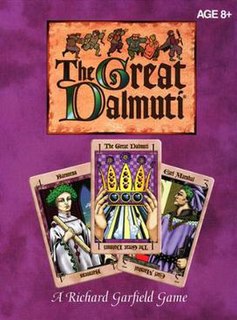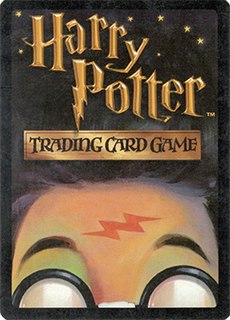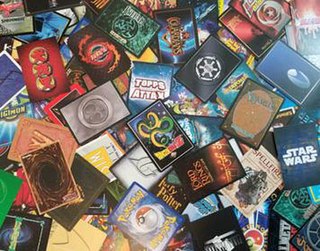
Magic: The Gathering is a tabletop and digital collectible card game created by Richard Garfield. Released in 1993 by Wizards of the Coast, Magic was the first trading card game and has approximately thirty-five million players as of December 2018, and over twenty billion Magic cards were produced in the period from 2008 to 2016, during which time it grew in popularity.

Richard Channing Garfield is an American mathematician, inventor and game designer. Garfield created Magic: The Gathering, which is considered to be the first modern collectible card game (CCG). Magic debuted in 1993 and its success spawned many imitations. Garfield oversaw the successful growth of Magic and followed it with other game designs. Included in these are Keyforge, Netrunner, BattleTech(CCG), Vampire: The Eternal Struggle, Star Wars Trading Card Game, The Great Dalmuti, Artifact and the board game RoboRally. He also created a variation of the card game Hearts called Complex Hearts. Garfield first became passionate about games when he played the roleplaying game Dungeons & Dragons, so he designed Magic decks to be customizable like roleplaying characters. Garfield and Magic are both in the Adventure Gaming Hall of Fame.
Several video games based on the Magic: The Gathering franchise exist for multiple systems. Some have attempted to translate the card game to electronic play nearly exactly; others have taken more liberties and drawn more from the setting than the actual rules of the card game. Benefits of successful video game versions of the card game include convenience, practice, and challenge. However, artificial intelligence for a game such as Magic is an extremely hard problem, and such software usually must be continuously updated to stay current with recently released card sets. Video game versions often expand on artwork, and may include unique cards that rely on randomness, effects which would be difficult or annoying to duplicate in real life.
Vampire: The Eternal Struggle is a multiplayer collectible card game published by White Wolf Publishing. It is set in the World of Darkness and is based on the Vampire: The Masquerade roleplaying game.
Magic: The Gathering Limited Edition is the first Magic: The Gathering card set. It premiered in a limited release at Origins Game Fair in 1993, with a general release that August. The initial print run of 2.6 million cards sold out quickly, and a new printing run was released in October 1993. These two runs are known as Limited Edition Alpha and Limited Edition Beta, or just Alpha and Beta for short. Although Alpha and Beta are referred to as different sets by some, officially they are the same set; Wizards of the Coast had expected that people wouldn't necessarily be able to tell the two press runs apart. Beta fixed a number of misprints and errors on cards. The printer accidentally used different corner rounding dies for the second run, resulting in Alpha cards being noticeably distinct in shape and appearance from Beta cards and all subsequent cards. The Beta printing also included a revised rulebook with a number of clarifications, although creator Richard Garfield's short fiction "Worzel's Tale" was removed to make room. The print run of Beta is given as 7.3 million or 7.8 million depending on the source. Despite the set's print run being about three times as big as Alpha's, Beta sold out as quickly as its predecessor.
The collectible card game Magic: The Gathering published seven expansion sets from 1993–1995, and one compilation set. These sets contained new cards that "expanded" on the base sets of Magic with their own mechanical theme and setting; these new cards could be played on their own, or mixed in with decks created from cards in the base sets. With Magic's runaway success, many of the printings of these early sets were too small to satisfy the rapidly growing fanbase. Cards from them became rare, hard to find, and expensive. It was not until Fallen Empires and Homelands that Wizards of the Coast was able to print enough cards to meet demand; additionally, Wizards of the Coast published Chronicles, a reprint set that helped fix many of the scarcity issues with the earliest sets.

The Great Dalmuti is a shedding-type card game published by Wizards of the Coast in 1995.
In Magic: The Gathering, Power Nine is a set of nine cards that were printed in the game's early core sets, consisting of Black Lotus, Ancestral Recall, Time Walk, Mox Pearl, Mox Sapphire, Mox Jet, Mox Ruby, Mox Emerald, and Timetwister.
The collectible card game Magic: The Gathering published ten base sets from 1993–2007, also referred to as core sets. With the exception of Limited Edition, these sets consisted entirely of reprints. These cards were generally simpler than cards in expansion sets, omitting multicolored cards, and used only the original abilities and keywords of Magic such as Flying and Trample. This simplicity led to many cards from these sets being considered "staples" of deck design. All cards were given a white border to mark them as reprints, with a few exceptions. From Fourth Edition in 1995 onward, a new base set would come out once per two years in the spring or early summer; for tournament play, that set would be legal for two years in the Standard format until the next core set replaced it.
Mirage was the first official block structure in Magic: The Gathering. This new block structure consisted of three expansion sets and would continue for nearly two decades, finally ending with Khans of Tarkir in 2014. The new block structure also set up the precedent that the first set in the block also became the name for the entire block. Mirage block consisted of three sets: Mirage, Visions and Weatherlight.

The Harry Potter Trading Card Game is an out-of-print collectible card game based in the world of J. K. Rowling's Harry Potter novels. Created by Wizards of the Coast in August 2001, the game was designed to compete with the Yu-Gi-Oh!, Pokémon and Magic: The Gathering card games. Its release was timed to coincide with the theatrical premiere of the first film in the series. The game was praised for the way it immersed children in the Harry Potter universe. At one point the game was the second best selling toy in the United States; however, it is now out of print.
Portal is the name given to the three Magic: The Gathering starter level sets. The original Portal was released on May 1, 1997, followed by Portal Second Age on June 24, 1998 and Portal Three Kingdoms on July 6, 1999. The Portal set was inspired by Chinese mythology; Three Kingdoms in particular by the 14th century Chinese historical novel Romance of the Three Kingdoms by Luo Guanzhong.
The collectible card game Magic: The Gathering has released compilation sets, reprint sets, and box sets over its history. These are distinct from core sets and expansion sets, the most heavily marketed sources of new cards. With the exception of Chronicles, reprint sets generally do not affect tournament legality in supported formats; for example, cards reprinted in the Modern Masters reprint set, while legal for tournament play, did not necessarily cause the card to be included in the "Standard" environment.
Starter is the name of two Magic: The Gathering starter-level sets. The first Starter was released on August 27, 1999 and was the fourth starter level set. It was followed by Starter 2000, the fifth and final starter set, on April 24, 2000.
On The Edge was a collectible card game released in 1994, not long after Magic: The Gathering. The setting and characters were based on the RPG titled Over the Edge. The game's story was set on an island in the southern Mediterranean called Al Amarja, where various factions were fighting for control.
Magic: The Gathering formats are various ways in which the Magic: The Gathering collectible card game can be played. Each format provides rules for deck construction and gameplay, with many confining the pool of permitted cards to those released in a specified group of Magic card sets. The DCI, the governing body that oversees official Magic competitive play, categorizes its tournament formats into Constructed and Limited.

A collectible card game (CCG), also called a trading card game (TCG), among other names, is a type of card game that mixes strategic deck building elements with features of trading cards, introduced with Magic: The Gathering in 1993.

The BattleTech Collectible Card Game is an out-of-print collectible card game (CCG) set in the BattleTech universe. The game was developed by Wizards of the Coast (WotC) for FASA and released in 1996.
A sideboard, side deck, or side is a set of cards in a collectible card game that are separate from a player's primary deck. It is used to customize a match strategy against an opponent by enabling a player to change the composition of the playing deck.

Magic: The Gathering Arena or MTG Arena is a free-to-play digital collectible card game developed and published by Wizards of the Coast (WotC). The game is a digital adaption of the Magic: The Gathering (MTG) card game, allowing players to gain cards through booster packs, in-game achievements or microtransaction purchases, and build their own decks to challenge other players. The game was released in a beta state in November 2017, and was fully released for Microsoft Windows users in September 2019, and a macOS version on June 25, 2020. Mobile device versions were released in March 2021.







